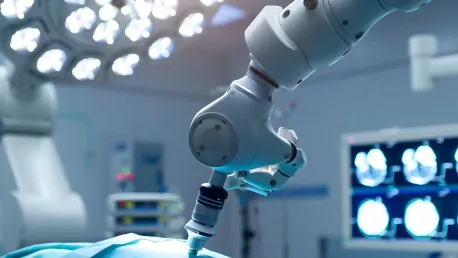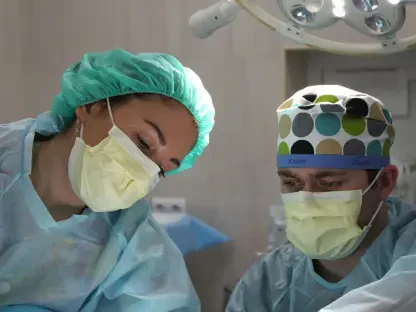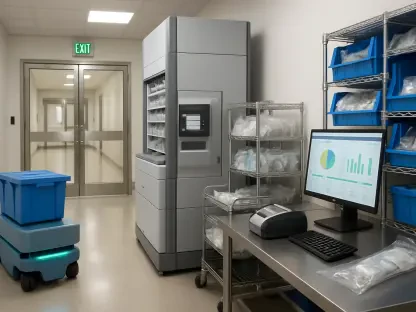In a significant milestone for surgical technology, Johnson & Johnson has successfully completed the first clinical surgeries using their Ottava robotic surgical system. This breakthrough marks substantial progress in J&J’s efforts to bring the Ottava robot to market despite previous delays in development. The procedures, conducted as part of a clinical trial, included gastric bypass surgeries, demonstrating the system’s capabilities and setting a promising precedent for future applications. Johnson & Johnson’s goal is to obtain U.S. FDA approval through a de novo submission, which aims for an indication covering various general surgery procedures in the upper abdomen.
Transforming the Operating Room
Innovative Design and Functionality
The Ottava robot is designed with four arms integrated into the operating table, which can be conveniently stored below when not in use, creating more workspace for clinical teams. This innovative design enhances the landscape of minimally invasive surgery, promising significant advancements in the field. Erik Wilson, the lead investigator for the trial, highlighted the potential of Ottava to set new standards in surgical robotics. The system’s design is not only practical but also aims to facilitate smoother, more efficient surgical procedures, reflecting a deep understanding of surgical team needs.
Ottava’s design and functionality focus on providing a comprehensive solution for soft tissue procedures using J&J’s Ethicon surgical instruments. The system is also equipped with a digital Polyphonic system, which integrates surgical technologies, robotics, and software to support clinical decision-making. This integration enables a more cohesive and streamlined approach to surgery, potentially reducing the likelihood of complications and improving patient outcomes. The Ottava robot’s expansive applicability illustrates its innovative nature and the broad range of surgical procedures it can support.
Clinical Trial and Results
The initial clinical trials of the Ottava robot included complex procedures such as gastric bypass surgeries, which are performed on the upper abdomen. These trials are crucial steps towards demonstrating the system’s capabilities in a real-world surgical environment and collecting data to support the submission for FDA approval. The success of these initial surgeries not only validates the robot’s design but also provides valuable insights into its practical applications and potential areas for further improvement.
The clinical trial phase is essential for gathering the necessary evidence to secure FDA approval, which would allow the Ottava robot to be used for various general surgery procedures in the upper abdomen. J&J’s commitment to rigorous testing and validation underscores their dedication to delivering a reliable and effective surgical tool. The trial’s results thus far indicate a promising future for Ottava, with potential implications for a wide range of surgical disciplines.
Challenging Market Dominance
Strategic Positioning and Market Impact
Johnson & Johnson’s entry into the surgical robotics market with the Ottava robot is a strategic move aimed at challenging the dominance of Intuitive Surgical’s da Vinci system. J&J already has a presence in the market with its Monarch robotic lung biopsy platform and Velys robot for orthopedic procedures. However, Ottava represents a critical addition to their portfolio, targeting a broader range of surgical applications. The competitive landscape in surgical robotics is intensifying, with major players like Medtronic also vying for FDA approval of their Hugo robotic system, anticipated to launch in the U.S. within the next two years.
Smaller companies like CMR Surgical and Moon Surgical have already secured U.S. authorizations, adding to the competitive dynamics. For Johnson & Johnson, the Ottava robot’s advanced features and comprehensive functionality provide a strong foundation to compete robustly in this market. This strategic positioning not only aims to capture market share but also to drive innovation and set new benchmarks in surgical robotics.
Broader Implications and Future Prospects
The development and successful clinical application of the Ottava robotic system have broader implications for the field of minimally invasive surgery. By integrating advanced robotics with surgical techniques, J&J is positioned to influence future surgical practices significantly. The innovation seen in the Ottava robot could lead to improved surgical outcomes, reduced recovery times for patients, and more efficient use of operating room resources. As the technology matures and gains regulatory approval, its impact on healthcare could be transformative, setting new standards for surgical precision and patient care.
Looking ahead, Johnson & Johnson’s ongoing commitment to improving surgical technology suggests that the Ottava robot could be just the beginning of a new era in robotic surgery. Continuous advancements and refinements in the system are likely, further enhancing its capabilities and applications. The competition in the market will undoubtedly drive innovation, ultimately benefiting patients and healthcare providers alike.
Conclusion: A New Era in Surgical Robotics
Johnson & Johnson’s recent completion of the first clinical surgeries using their Ottava robotic surgical system marks a significant advancement in surgical technology. This milestone highlights considerable progress in the company’s efforts to introduce the Ottava robot to the market, despite experiencing prior development delays. The clinical trial involved gastric bypass surgeries, successfully showcasing the capabilities of the Ottava system and setting a positive precedent for future medical applications. Johnson & Johnson aims to secure U.S. FDA approval via a de novo submission, which targets an indication for various general surgery procedures in the upper abdomen. By achieving FDA approval, J&J hopes the Ottava system will revolutionize surgical practices, offering enhanced precision and outcomes. This breakthrough not only demonstrates technological innovation but also signifies a potential shift in the future of surgical procedures, where robotics might play a central role in improving patient care and expanding the possibilities within the field of surgery.









